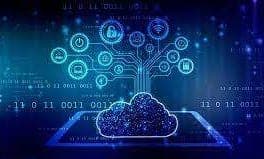

Cloud Computing
Cloud Computing is an upcoming field in the IT sector which has revolutionary impacts in the digital world. It employs the powerful technology of worldwide networking to get the infrastructure needed anywhere on earth without actually having them on-spot.
A Brief
By definition, Cloud Computing is an on-demand services of computer system resources, especially data storage and computing power, without much user interference. The physical infrastructure will be distributed over a large number of geographical locations and still be available digitally anywhere.
History
The term cloud was used to refer to platforms for distributed computing as early as 1993, when Apple spin-off General Magic and AT&T used it in describing their (paired) Telescript and Personal Link technologies.
In July 2002, Amazon created the subsidiary Amazon Web Services. In March 2006 Amazon introduced its Simple Storage Service followed by Elastic Compute Cloud in August of the same year. These products pioneered the usage of server virtualization to deliver IaaS at a cheaper and on-demand pricing basis.
This is how it started. Then tech-giants like Google and Microsoft started investing and building infrastructure.
Definition
US National Institute of Standards and Technology defines Cloud Computing as “ Cloud computing is a model for enabling ubiquitous, convenient, on-demand network access to a shared pool of configurable computing resources (e.g networks, servers, storage, applications, and services) that can be rapidly provisioned and released with minimal management effort or service provider interaction. ”
Characteristics
On-demand self-service \t> A consumer can unilaterally provision computing capabilities, such as server time and network storage, as needed automatically without requiring human interaction with each service provider.
Broad network access
Capabilities are available over the network and accessed through standard mechanisms that promote use by heterogeneous thin or thick client platforms (e.g., mobile phones, tablets, laptops, and workstations).
Resource pooling
The provider’s computing resources are pooled to serve multiple consumers using a multi-tenant model, with different physical and virtual resources dynamically assigned and reassigned according to consumer demand.
Measured Service
Cloud systems automatically control and optimize resource use by leveraging a metering capability at some level of abstraction appropriate to the type of service (e.g., storage, processing, bandwidth, and active user accounts).
Resource usage can be Resource usage can be monitored, controlled, and reported, providing transparency for both the provider and consumer of the utilized service.
Rapid elasticity
Capabilities can be elastically provisioned and released, in some cases automatically, to scale rapidly outward and inward commensurate with demand. To the consumer, the capabilities available for provisioning often appear to be unlimited and can be appropriated in any quantity at any time.
Resource pooling
The provider’s computing resources are pooled to serve multiple consumers using a multi-tenant mode with different physical and virtual resources dynamically assigned and reassigned according to consumer demand.
Cloud Services Models
Cloud Services can be divided into three main categories depending on what resources are included. They are:
Software as a Service [SaaS]
The capability provided to the consumer is to use the provider’s applications running on a cloud infrastructure. The applications are accessible from various client devices through either a thin client interface, such as a web browser (e.g., web-based email), or a program interface.
The consumer does not manage or control the underlying cloud infrastructure including network, servers, operating systems storage, or even individual application capabilities, with the possible exception of limited user-specific application configuration settings.
e.g: Google Spread Sheet
Infrastructure as a Service [IaaS]
The capability provided to provision processing, storage, networks, and other fundamental computing resources. Consumer can deploy and run arbitrary software.
e.g: Amazon Web Services
Platform as a Service [Paas]
The capability provided to the consumer is to deploy onto the cloud infrastructure consumer-created or acquired applications created using programming languages, libraries, services, and tools supported by the provider.
The consumer does not manage or control the underlying cloud infrastructure including network, servers, operating systems, or storage, but has control over the deployed applications and possibly configuration settings for the application-hosting environment.
e.g: Google App Engine
Cloud Deployment Models
Private Cloud
The cloud infrastructure is operated solely for an organization.
Community Cloud
The cloud infrastructure is shared by several organizations and supports a specific goal.
Public Cloud
The cloud infrastructure is made available to the general public.
Hybrid Cloud
The cloud infrastructure is a composition of two or more clouds (private, community, or public).
Overview
Overall, Cloud Computing is a necessary and huge-impact brewing tool which has and will change the whereabouts of the digital breakthroughs.